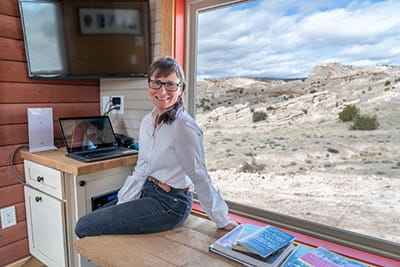Less House, More Purpose: Downsizing and Its Impact on Estate Planning

As values and priorities continuously shift across generations, so do the elements of what contributes to the pursuit of happiness. While owning a large and impressive home historically served as a symbol of success, changing values suggest that leading a meaningful, purposeful life is the key to true happiness. Downsizing conversations with your clients can provide value in helping your clients achieve their lifestyle, financial, and philanthropic goals.
Dr. Michael Finke, a well-known figure in wealth management and financial planning, recently explored the topic of retirement happiness on the Standard Deviations Podcast. His research uncovered three key pillars of happiness, which surprisingly did not revolve around the type, size, or location of one’s home. Instead, they centered on health, social connections, and having and enough money to enable the other two.
Finke’s findings align with Maslow’s hierarchy of needs. Shelter, personal security, and property are all housed in the two bottom levels of physiological and safety needs. They are foundational elements, but not the means through which to achieve the heights of human satisfaction. Instead, higher levels of belonging, love, and feelings of accomplishment are attained through experiences and relationships.
Rethinking the American Dream
If the key to happiness lies within social connections and experiences, why has the traditional American dream instead focused so heavily on the size and location of a one's home? Perhaps because, historically, a home was a gathering place for multiple generations of family, fostering connection and serving as a symbol of esteem. Today, this is not often the case. Yet, we are stuck and needing a change, as the dispersed, modern family has continued to prioritize a large home without the people inside that could make the space purposeful and worth the cost.
An excess of unused or forgotten possessions often go hand-in-hand with homes that are typically too large for the modern family. Despite our tendency to attach meaningful memories to the things we collect, if homes are filled with things, these are equally unlikely to contribute to life satisfaction. Memories exist in our minds, not in our homes. Research within a younger demographic confirms the idea that things–a home, furniture, a collection of Star Wars bobbleheads–in isolation, do not bring us happiness. It’s whether these possessions connect us with others that bring us joy. However, it’s the same underused or forgotten possessions that may hold the key to philanthropic giving solutions for your clients.
Purposeful Living
It is time to question the idea that the expected path for most young people should include a starter home with lifetime upgrades. While there is the opportunity of home equity, it is often at the sacrifice of other higher-order needs. In the current housing environment, the average American spends a third or more of their income on that lowest level need–shelter. This seems out of alignment with what makes humans feel fulfilled.
In conjunction with the changing emphasis of how income is allocated, incorporating purpose into financial planning across life-path, portfolio, and giving strategies is becoming increasingly important. The Millennial Generation, sometimes referred to as “The Purpose Generation,” continues to increase its power, influence, and wealth. Millennials overwhelmingly want to have an impact in all aspects of their lives and are conscious of how they can contribute to the causes that matter to them. They are shifting away from prioritizing ownership, inspiring the rise of sharing of resources like Uber, Airbnb, and co-working spaces.
Another related question to consider is why we as financial professionals do not challenge older clients who prioritize staying in their homes above all else. Social isolation and loneliness are linked with cognitive and physical health crises that eat away at a clients’ wealth. The alternative doesn’t have to be an independent living facility, though that is certainly a good fit for many. There are many other creative living arrangements that foster social connection and collaboration. Talking to your older clients openly and honestly about the benefits of downsizing and donating their assets to charity could be the answer to helping them achieve personal and philanthropic goals, unburdening themselves from the cost of home ownership, cars, and other physical possessions that could greatly benefit the causes they are passionate about.
I personally witnessed the benefits of downsizing when my father passed away following two massive strokes. I helped my mother clean out almost 40 years of accumulated possessions and put her house on the market. Selling her home opened up new opportunities. Downsizing freed her from the burdens of home maintenance and loneliness. Today, she co-houses with her sister, shares caregiving responsibilities for disabled family members, volunteers for groups she believes in, and has the key connections that fuel good mental and physical health.
Another creative solution gaining momentum is the tiny house movement, of which I am a passionate advocate. Tiny living communities are sprouting up throughout the country, creating spaces and resources that promote health and social connections. Tiny homes cost about one third of the national average home, require less maintenance and energy, and free up resources for people and experiences. Tiny living shifts the focus away from materialism to intentionality, creating space for purpose and meaningful connections.
Unlocking Lifetime Fulfillment and Impact
There are many compelling reasons to encourage your clients of all ages to allocate their valuable resources toward meaningful pursuits rather than maintaining large homes that consume resources, isolate them from vital social interactions, and divert attention from purpose-driven activities. However, we must think outside the box when planning a downsize, as so much of the home-building industry is stuck in a McMansion romance.
When your clients are ready to have a downsizing conversation, they may be surprised to learn that a wide range of physical property can be donated to benefit the organizations that they care about. Gifts of real estate, cars, art collections, wine, and so much more are often accepted by charities, allowing your clients to feel fulfilled in their personal living space while making a lasting impact on causes they are passionate about.
You can help your clients embrace downsizing in all aspects of life, encouraging them to focus their time, energy, attention, and wealth on charitable causes and their overall health and purposeful living.
About the Author

Laura Lynch, CFP®, ABFP™, AAMS®, CDFA®
Laura has years of experience in the financial planning industry and has honed her expertise in helping clients navigate the complex world of personal finance. Her focus on alternative living arrangements, particularly building and buying tiny homes, allows her to provide specialized guidance to those seeking financial freedom through downsizing houses and embracing less conventional means.
Laura's journey to tiny house living began with her own quest for financial freedom and a desire to live a life that aligned with her values. After experiencing the emotional and financial burdens of conventional homeownership, she and her partner Eric embarked on a journey to build their own tiny house, finding peace and liberation in their alternative living arrangement.




